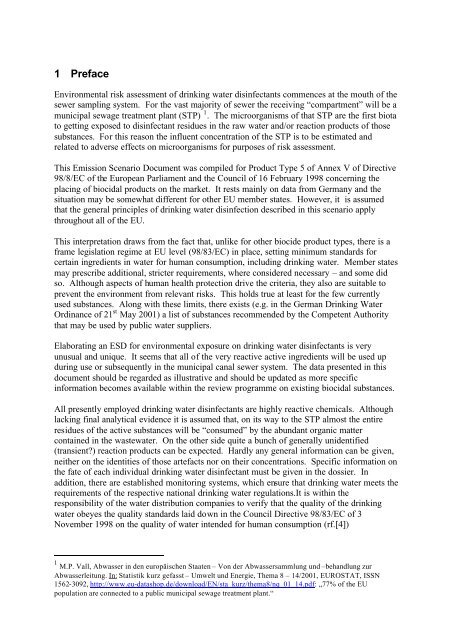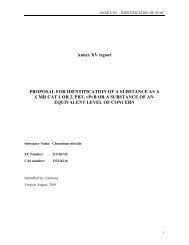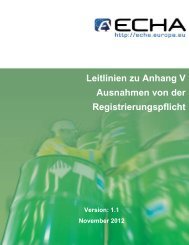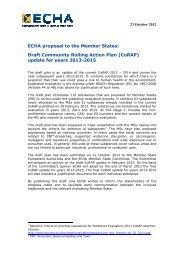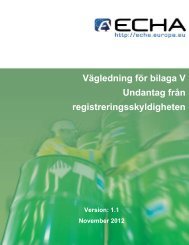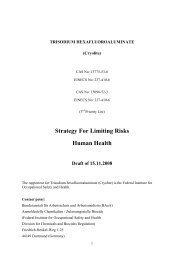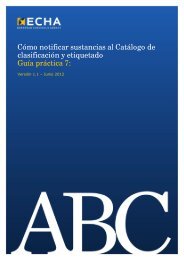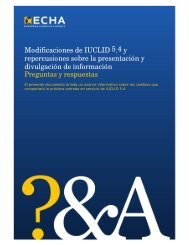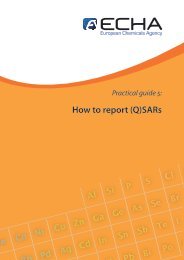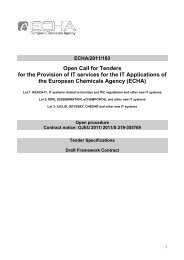EUBEES - ECHA - Europa
EUBEES - ECHA - Europa
EUBEES - ECHA - Europa
Create successful ePaper yourself
Turn your PDF publications into a flip-book with our unique Google optimized e-Paper software.
1 Preface<br />
Environmental risk assessment of drinking water disinfectants commences at the mouth of the<br />
sewer sampling system. For the vast majority of sewer the receiving “compartment” will be a<br />
municipal sewage treatment plant (STP) 1 . The microorganisms of that STP are the first biota<br />
to getting exposed to disinfectant residues in the raw water and/or reaction products of those<br />
substances. For this reason the influent concentration of the STP is to be estimated and<br />
related to adverse effects on microorganisms for purposes of risk assessment.<br />
This Emission Scenario Document was compiled for Product Type 5 of Annex V of Directive<br />
98/8/EC of the European Parliament and the Council of 16 February 1998 concerning the<br />
placing of biocidal products on the market. It rests mainly on data from Germany and the<br />
situation may be somewhat different for other EU member states. However, it is assumed<br />
that the general principles of drinking water disinfection described in this scenario apply<br />
throughout all of the EU.<br />
This interpretation draws from the fact that, unlike for other biocide product types, there is a<br />
frame legislation regime at EU level (98/83/EC) in place, setting minimum standards for<br />
certain ingredients in water for human consumption, including drinking water. Member states<br />
may prescribe additional, stricter requirements, where considered necessary – and some did<br />
so. Although aspects of human health protection drive the criteria, they also are suitable to<br />
prevent the environment from relevant risks. This holds true at least for the few currently<br />
used substances. Along with these limits, there exists (e.g. in the German Drinking Water<br />
Ordinance of 21 st May 2001) a list of substances recommended by the Competent Authority<br />
that may be used by public water suppliers.<br />
Elaborating an ESD for environmental exposure on drinking water disinfectants is very<br />
unusual and unique. It seems that all of the very reactive active ingredients will be used up<br />
during use or subsequently in the municipal canal sewer system. The data presented in this<br />
document should be regarded as illustrative and should be updated as more specific<br />
information becomes available within the review programme on existing biocidal substances.<br />
All presently employed drinking water disinfectants are highly reactive chemicals. Although<br />
lacking final analytical evidence it is assumed that, on its way to the STP almost the entire<br />
residues of the active substances will be “consumed” by the abundant organic matter<br />
contained in the wastewater. On the other side quite a bunch of generally unidentified<br />
(transient?) reaction products can be expected. Hardly any general information can be given,<br />
neither on the identities of those artefacts nor on their concentrations. Specific information on<br />
the fate of each individual drinking water disinfectant must be given in the dossier. In<br />
addition, there are established monitoring systems, which ensure that drinking water meets the<br />
requirements of the respective national drinking water regulations.It is within the<br />
responsibility of the water distribution companies to verify that the quality of the drinking<br />
water obeyes the quality standards laid down in the Council Directive 98/83/EC of 3<br />
November 1998 on the quality of water intended for human consumption (rf.[4])<br />
1 M.P. Vall, Abwasser in den europäischen Staaten – Von der Abwassersammlung und –behandlung zur<br />
Abwasserleitung. In: Statistik kurz gefasst – Umwelt und Energie, Thema 8 – 14/2001, EUROSTAT, ISSN<br />
1562-3092, http://www.eu-datashop.de/download/EN/sta_kurz/thema8/nq_01_14.pdf: „77% of the EU<br />
population are connected to a public municipal sewage treatment plant.“


